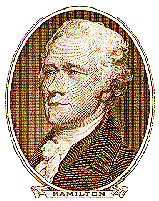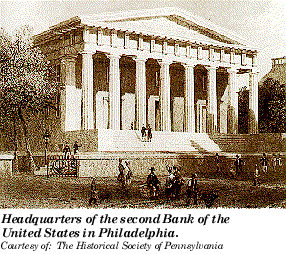  Because of their crucial importance to the life of the community, U.S.
banks have always operated under rules more demanding than those applied to other
businesses. In most states of the early federal union, bank organizers needed special
permission from the state government to open and operate. Because of their crucial importance to the life of the community, U.S.
banks have always operated under rules more demanding than those applied to other
businesses. In most states of the early federal union, bank organizers needed special
permission from the state government to open and operate. For a while, an additional
layer of oversight was provided by the Bank of the United States, a central bank founded
in 1791 at the initiative of the nation's first Secretary of the Treasury, Alexander
Hamilton. Its Congressional charter expired in 1811. A second Bank of the United States
was created in 1816 and operated until 1832.
 In those days, city bankers
tended to be extremely cautious about to whom they lent and for how long. To make sure
they had enough cash available to meet unexpected demands from depositors, bankers
generally made short-term loans only. Thirty to sixty days was the norm. Typically
manufacturers and shopkeepers would use these funds to pay their suppliers and workers
until they could sell the goods to customers. After that sale they would pay off the bank
loan. In those days, city bankers
tended to be extremely cautious about to whom they lent and for how long. To make sure
they had enough cash available to meet unexpected demands from depositors, bankers
generally made short-term loans only. Thirty to sixty days was the norm. Typically
manufacturers and shopkeepers would use these funds to pay their suppliers and workers
until they could sell the goods to customers. After that sale they would pay off the bank
loan.
More of the Changing World of Banking:
 Introduction Introduction 1790 to 1832 1790 to 1832 1832 to 1864 1832 to 1864
 1865 to 1914 1865 to 1914
 1929 to 1970 1929 to 1970  1970 to Today 1970 to Today
|




 In those days, city bankers
tended to be extremely cautious about to whom they lent and for how long. To make sure
they had enough cash available to meet unexpected demands from depositors, bankers
generally made short-term loans only. Thirty to sixty days was the norm. Typically
manufacturers and shopkeepers would use these funds to pay their suppliers and workers
until they could sell the goods to customers. After that sale they would pay off the bank
loan.
In those days, city bankers
tended to be extremely cautious about to whom they lent and for how long. To make sure
they had enough cash available to meet unexpected demands from depositors, bankers
generally made short-term loans only. Thirty to sixty days was the norm. Typically
manufacturers and shopkeepers would use these funds to pay their suppliers and workers
until they could sell the goods to customers. After that sale they would pay off the bank
loan.

 1790 to 1832
1790 to 1832


